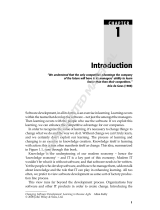Page is loading ...

Direct from Development
Server and Infrastructure Engineering
Copyright © 2020 Dell Inc. or its subsidiaries. All Rights Reserved.
Dell, EMC and other trademarks are trademarks of Dell Inc. or its subsidiaries
Virtualized GPU Instances on Dell EMC PowerEdge
Platforms for Compute Intensive Workloads
AI adoption is growing in many organizations leading to increased
demand of GPU accelerated compute instances. We explore how
IT teams can leverage existing investment in virtualized
infrastructure combined with NVIDIA Virtual GPU software to
provide optimized and secure GPU-ready compute environments
for AI researcher and engineers.
Motivation for GPU Virtualization
The requirement and demand for GPU accelerated compute
instances is steadily rising in all organizations, driven primarily by
rise of AI and Deep Learning (DL) techniques to realize increased
efficiencies and improve customer interactions. IT environments
continue to adopt virtualization to run all workloads and address
requirements of providing secure and agile compute capabilities to
end users. NVIDIA Virtual GPU software (previously referred to as
GRID) enables virtualizing a physical GPU and allows it to be
shared across multiple virtual machines. The rising demand for
GPU accelerated compute instances can be achieved by
virtualizing GPUs and deploying cost effective GPU accelerated
VM instances. Enabling a centralized and hosted solution in the
data center provides the security and scalability that is critical to
enterprise customers.
NVIDIA Virtual GPU
software enables virtual
GPUs to be created on a
Dell EMC server with
NVIDIA GPUs that can be
shared across multiple
virtual machines. Better
utilization and sharing are
achieved by transforming
a one-to-one relationship
from GPU to user to one-
to-many.
Tech Note by
Ramesh Radhakrishnan
Janet Morss
Mike Bennett
Matt Ogle
Summary
In this DfD we address a
common problem that is
faced by IT teams across
different organizations –
being able to efficiently
share and utilize NVIDIA
GPU resources across
different teams and
projects.
Figure 1. GPU enabled VM instances using GPU
Pass-Though and GPU Virtualization (vGPU)

Copyright © 2020 Dell Inc. or its subsidiaries. All Rights Reserved.
Dell, EMC and other trademarks are trademarks of Dell Inc. or its subsidiaries
Copyright © 2020 Dell Inc. or its subsidiaries. All Rights Reserved.
Dell, EMC and other trademarks are trademarks of Dell Inc. or its subsidiaries
Traditionally, the IT best practices for compute-intensive (non-graphical) VM instances leveraged
GPU pass-through shown in the left half of Figure 1. In a VMware environment, this is referred to as
the VM DirectPath I/O mode of operation. It allows the GPU device to be accessed directly by the
guest operating system, bypassing the ESXi hypervisor. This provides a level of performance of a
GPU on vSphere that is very close to its performance on a native system (within 4-5%).
The main reasons for using the passthrough approach to expose GPUs on vSphere are:
(i) Simplicity: It is straightforward to allocate GPUs to a VM using pass-though and offer GPU
acceleration benefits to end users
(ii) Dedicated use: there is no need for sharing the GPU among different VMs, because a single
application will consume one or more full GPUs
(iii) Replicate public cloud instances: public cloud instances use GPU pass-through, and end
user wants the same environment in an on-premises datacenter
(iv) A single virtual machine can make use of multiple physical GPUs in passthrough mode
An important point to note is that the passthrough option for GPUs works without third-party software
driver being loaded into the ESXi hypervisor.
Disadvantages of GPU passthrough is as follows:
(i) The entire GPU is dedicated to that VM and there is no sharing of GPUs amongst the VMs
on a server.
(ii) Advanced vSphere features of vMotion, Distributed Resource Scheduling (DRS) and
Snapshots are not allowed with this form of using GPUs with a virtual machine.
Overview of NVIDIA vGPU Platform
GPU virtualization (NVIDIA vGPU) addresses limitations of pass-through but was traditionally
deployed to accelerate virtualized profession graphics applications, virtual desktop instances or
remote desktop solutions. NVIDIA added support for AI, DL and high-performance computing (HPC)
workloads in GRID 9.0 that was released in summer 2019. It also changed vGPU licensing to make
it more amenable for compute use cases. GRID vPC/vApps and Quadro vDWS are licensed by
concurrent user, either as a perpetual license or yearly subscription. Since vComputeServer is for
server compute workloads, the license is tied to the GPU rather than a user and is therefore licensed
per GPU as a yearly subscription. For more information about NVIDIA GRID software, see
http://www.nvidia.com/grid.
Figure 2 shows the different components of the Virtual GPU software stack.

Copyright © 2020 Dell Inc. or its subsidiaries. All Rights Reserved.
Dell, EMC and other trademarks are trademarks of Dell Inc. or its subsidiaries
Copyright © 2020 Dell Inc. or its subsidiaries. All Rights Reserved.
Dell, EMC and other trademarks are trademarks of Dell Inc. or its subsidiaries
NVIDIA GPU Virtualization software transforms a physical GPU installed on a server to create virtual
GPUs (vGPU) that can be shared across multiple virtual machines. The focus in this paper is on the
use of GPUs for compute workloads using vComputeServer profile introduced in GRID 9. We are
not looking at GPU usage for professional graphics or virtual desktop infrastructure (VDI) that will
leverage Quadro vDWS or GRID vPC and vAPP profiles. GRID vPC/vApps and Quadro vDWS are
client compute products for virtual graphics designed for knowledge workers and professional
graphics use. vComputeServer is targeted for compute-intensive server workloads, such as AI, deep
learning, and Data Science.
In an ESXi environment, the lower layers of the stack include the NVIDIA Virtual GPU Manager, that
is loaded as a VMware Installation Bundle (VIB) into the vSphere ESXi hypervisor. An additional
guest OS NVIDIA vGPU driver is installed within the guest operating system of your virtual machine.
Using the NVIDIA vGPU technology with vSphere provides options during creation of the VMs to
dedicate a full GPU device(s) to one virtual machine or to allow partial sharing of a GPU device by
more than one virtual machine.
IT admins will pick between the options depending on the application and user requirements:
• Partial GPUs: For AI dev environments a data scientist VM will not need the power of full
GPU
• GPU sharing: IT admins want GPUs to be share by more than one team of users
simultaneously
• High priority applications: dedicate a full GPU or multiple GPUs to one VM
Figure 2. GPU enabled VM instances using GPU Pass-
Though and GPU Virtualization (vGPU)

Copyright © 2020 Dell Inc. or its subsidiaries. All Rights Reserved.
Dell, EMC and other trademarks are trademarks of Dell Inc. or its subsidiaries
Copyright © 2020 Dell Inc. or its subsidiaries. All Rights Reserved.
Dell, EMC and other trademarks are trademarks of Dell Inc. or its subsidiaries
The different editions of the vGPU driver are described next.
NVIDIA virtual GPU Software is available in four editions that deliver accelerated virtual desktops to
support the needs of different workloads.
IT administrators can configure VMs using vComputeServer (vCS) profiles to deploy GPU compute
instances on top of Dell EMC PowerEdge servers configured with NVIDIA V100 or T4 GPUs. Details
of vCS GPU profile and list of Dell EMC Servers that can be used to run VMs accelerated using vCS
GPU profiles is provided in the following tables. IT teams have a range of options in terms of vGPU
profiles, GPU Models and supported Dell platforms to accommodate the compute requirements of
their customer workloads.

Copyright © 2020 Dell Inc. or its subsidiaries. All Rights Reserved.
Dell, EMC and other trademarks are trademarks of Dell Inc. or its subsidiaries
Follow Us
For PowerEdge news
Contact Us
For feedback and requests
PowerEdge DfD Repository
For more technical learning
Copyright © 2020 Dell Inc. or its subsidiaries. All Rights Reserved.
Dell, EMC and other trademarks are trademarks of Dell Inc. or its subsidiaries
vComputeServer Features and Deployment Patterns
vComputeServer was designed to complement existing GPU virtualization capabilities for graphics
and VDI and address the needs of the data centers to virtualize compute-intensive workloads such
as AI, DL and HPC. As part of addressing the needs of compute-intensive workloads, vCS
introduced GPU aggregation inside a VM (multi vGPU support in a VM), GPU P2P support for
NVLink, container support using NGC and support for application, VM, and host-level monitoring. A
few of the key features are:
Management and monitoring: Admins can use the VMware management tools like VMware
vSphere to manage GPU servers, with visibility at the host, VM and app level. GPU-enabled virtual
machines can be migrated with minimal disruption or downtime.
Multi vGPU support: Administrators can now combine management benefits of vGPU and leverage
the compute capability of scaling-out jobs across multiple GPUs by leveraging multi vGPU support
in vComputeServer. Multiple vGPUs can now be deployed in a single virtual machine to scale
application performance and speed up production workflows.
Support for NGC Software: vComputeServer supports NVIDIA NGC GPU-optimized software for
deep learning, machine learning, and HPC. NGC software includes containers for the popular AI
and data science software, validated and optimized by NVIDIA, as well as fully-tested containers for
HPC applications and data analytics. NGC also offers pre-trained models for a variety of common
AI tasks that are optimized for NVIDIA Tensor Core GPUs. This allows data scientists, developers,
and researchers to reduce deployment times focus on building solutions, gathering insights, and
delivering business value.
Deploying Virtualized GPU Instances for Compute Intensive Workloads
In this paper we covered the benefits of deploying virtualized VMs that can leverage GPU compute
for accelerating emerging workloads like AI, Deep Learning and HPC. Customers that care about
highest performance can leverage virtualized instances of NVIDIA V100 GPU in their VMs and also
aggregate multiple vGPUs on Dell PE-C4140 server to get increased performance using GPU
aggregation capability of vComputeServer profile. Customers concerned about cost can share a
GPU between multiple users by leveraging smaller vGPU profiles (upto 16 vGPU profiles can be
created from a single V100 or T4 GPU).
/

